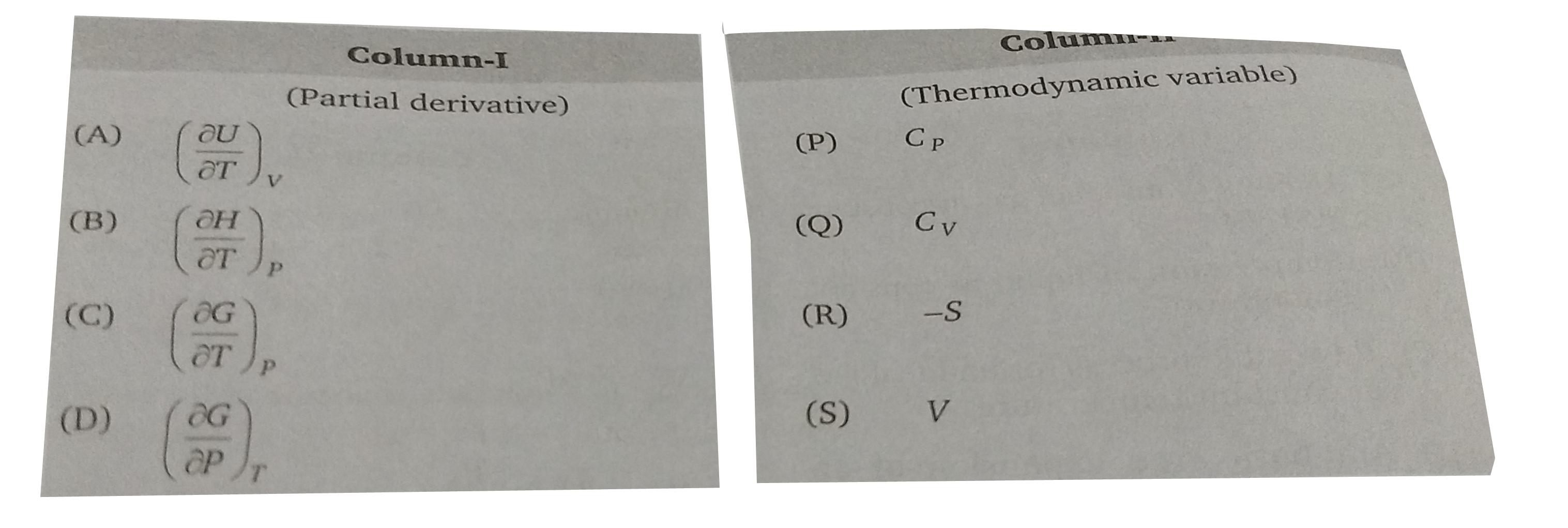Consider the ΔG∘f and ΔH∘f (kJ/mol) for the following oxides. Which can be most easily decomposed to form the metal and oxygen gas?Solution in Punjabi
ZnO(ΔG∘=−318.4,ΔH∘=−348.3)
Cu2O(ΔG∘=−146.0,ΔH∘=−168.8)
HgO(ΔG∘=−58.5,ΔH∘=−90.8)
PbO(ΔG∘=−187.9,ΔH∘=−217.3)
The correct Answer is:C
ΔG∘=−RTlnK, K↑stability of reactant↓
Topper's Solved these Questions
- THERMODYNAMICSBOOK - NARENDRA AWASTHICHAPTER - THERMODYNAMICSEXERCISE - Level 3 - One Or More Answers Are Correct
1 Video
- THERMODYNAMICSBOOK - NARENDRA AWASTHICHAPTER - THERMODYNAMICSEXERCISE - Level 3 - Match The Column
2 Videos
- THERMODYNAMICSBOOK - NARENDRA AWASTHICHAPTER - THERMODYNAMICSEXERCISE - Level 2 (Q.1 To Q.30)
1 Video
- STOICHIOMETRYBOOK - NARENDRA AWASTHICHAPTER - STOICHIOMETRYEXERCISE - Level 3 - Subjective Problems
20 Videos
Similar Questions
Assume ideal gas behaviour for all the gases considered and neglect vibrational degrees of freedom. Separate equimolar sample. Separate equimolar samples of Ne, O2 , CO2 and SO2 were subjected to a two process as mentioned. Initially all are at same state of temperature and pressue.
Step I → All undergo reversible adiabatic expansion to attain same final volume, which is double the original volume thereby causing the decreases in their temperature.
Step → After step I all are given appropriate amount of heat isochorically to restore the original temperature.
Mark the correct option(s) :
View SolutionMatch the following columns

View SolutionWrite structure of 2,2-dimethylheptane.
View SolutionWhat volume of a liquid (in L) will contain 10 mole ? If molar mass of liquid is 280 and its density is 1.4 g/mL.
View SolutionConsider the ΔG∘f and ΔH∘f (kJ/mol) for the following oxides. Which can be most easily decomposedto form the metal and oxygen gas?
View SolutionFind bond enthalpy of C=O (in kJ/mol) using following information :
ΔHatomisation[C(s)]=700 kJ/mol
ΔHf[CO2(g)]=−400 kJ/mol
BEo=o=500 kJ/mol
Resonance energy of CO2=−150 kJ/mol
View SolutionFor the following cell reaction,
Ag∣∣Ag+∣∣AgCl∣∣Cl−∣∣Cl2,Pt
ΔG0f(AgCl)=−109kJ/mol
ΔG0f(Cl)=−129kJ/mol
ΔG0f(Ag+)=78kJ/mol
E∘ of the cell is
View SolutionGiven C_(2)H_(2)(g)+H_(2)(g)rarrC_(2)H_(4)(g): DeltaH^(@)=-175 " kJ mol"^(-1) DeltaH_(f(C_(2)H_(4),g))^(@)=50 " kJ mol"^(-1), DeltaH_(f(H_(2)O,l))^(@)=-280 " kJ mol"^(-1), DeltaH_(f(CO_(2)g))^(@)=-390 " kJ mol"^(-1) If DeltaH^(@) is enthalpy of combustion (in kJ "mol"^(-1) ) of C_(2)H_(2) (g), then calculate the value of |(DeltaH^(@))/(257)|
View SolutionWhat is the Bond energy (In kJ/ mol) of C−H in Methane from the following data?
ΔHf[CO2(g)]=−394kJ/molΔHf[H2O(l)]=−285kJ/molΔHsiblimation{Carbon (graphite)}=+716kJ/molΔHcombustion[CH4(g)]=−890kJ/molBond energy(H−H)=435kJ/mol
View SolutionCalculate the DeltaH_(f)^@ of C_(6)H_(12)O_(6) (s) from the following data: DeltaH_(comb)[C_(6)H_(12)O_(6)(s)]=-2816.kJ//mol DeltaH_(f)^(@) of CO_(2)(g)=-393.5kJ//mol DeltaH_(f)^(@) of H_(2)O(l)=-285.9kJ//mol
View SolutionConsider the DeltaG_(f)^(@) (kJ/mol) for the following oxides. Which oxide can be most easily decomposed to form the metal and oxygen gas?
View SolutionDeltaH_(f)^(@) of NF_(3) is -113 kJ mol^(-1) and N-F bond energy is 273.0 kJ mol^(-1) . If N-=N and F-F bond energies are in the rates 6:1, their magnetudes will be
View SolutionThe minimum voltage required to electrolyse alumina in the Hall-Herout process is
[Given, ΔG∘(f)(Al2O3)=−1520kJ/mol and ΔG∘(f)(CO2)=394kJ/mol]
View SolutionConsider the DeltaG_(f)^(0) and Delta H_(f)^(0) (kJ/mol) for the following oxides. Which oxide can be most easily decomposed to form the metal and oxygen gas?
View SolutionDeltaG_(f)^(@) values for the formation of CuO, CO and H_(2)O are respectively -129.7, -137.2 and -237.2 kJ mol^(-1) respectively. In between carbon and hydrogen, which is good reductant for reduction of the metal oxide. Why?
View Solution
